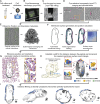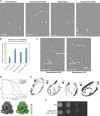Cytoplasmic ribosomes on mitochondria alter the local membrane environment for protein import
- PMID: 40047641
- PMCID: PMC11893167
- DOI: 10.1083/jcb.202407110
Cytoplasmic ribosomes on mitochondria alter the local membrane environment for protein import
Abstract
Most of the mitochondria proteome is nuclear-encoded, synthesized by cytoplasmic ribosomes, and targeted to the mitochondria posttranslationally. However, a subset of mitochondrial-targeted proteins is imported co-translationally, although the molecular mechanisms governing this process remain unclear. We employ cellular cryo-electron tomography to visualize interactions between cytoplasmic ribosomes and mitochondria in Saccharomyces cerevisiae. We use surface morphometrics tools to identify a subset of ribosomes optimally oriented on mitochondrial membranes for protein import. This allows us to establish the first subtomogram average structure of a cytoplasmic ribosome at the mitochondrial surface in the native cellular context, which showed three distinct connections with the outer mitochondrial membrane surrounding the peptide exit tunnel. Further, this analysis demonstrated that cytoplasmic ribosomes primed for mitochondrial protein import cluster on the outer mitochondrial membrane at sites of local constrictions of the outer and inner mitochondrial membranes. Overall, our study reveals the architecture and the spatial organization of cytoplasmic ribosomes at the mitochondrial surface, providing a native cellular context to define the mechanisms that mediate efficient mitochondrial co-translational protein import.
© 2025 Chang et al.
Conflict of interest statement
Disclosures: The authors declare no competing interests exist.
Figures







Update of
-
Cytoplasmic ribosomes on mitochondria alter the local membrane environment for protein import.bioRxiv [Preprint]. 2024 Jul 19:2024.07.17.604013. doi: 10.1101/2024.07.17.604013. bioRxiv. 2024. Update in: J Cell Biol. 2025 Apr 07;224(4):e202407110. doi: 10.1083/jcb.202407110. PMID: 39071314 Free PMC article. Updated. Preprint.
References
-
- Becker, T., Bhushan S., Jarasch A., Armache J.-P., Funes S., Jossinet F., Gumbart J., Mielke T., Berninghausen O., Schulten K., et al. . 2009. Structure of monomeric yeast and mammalian Sec61 complexes interacting with the translating ribosome. Science. 326:1369–1373. 10.1126/science.1178535 - DOI - PMC - PubMed

